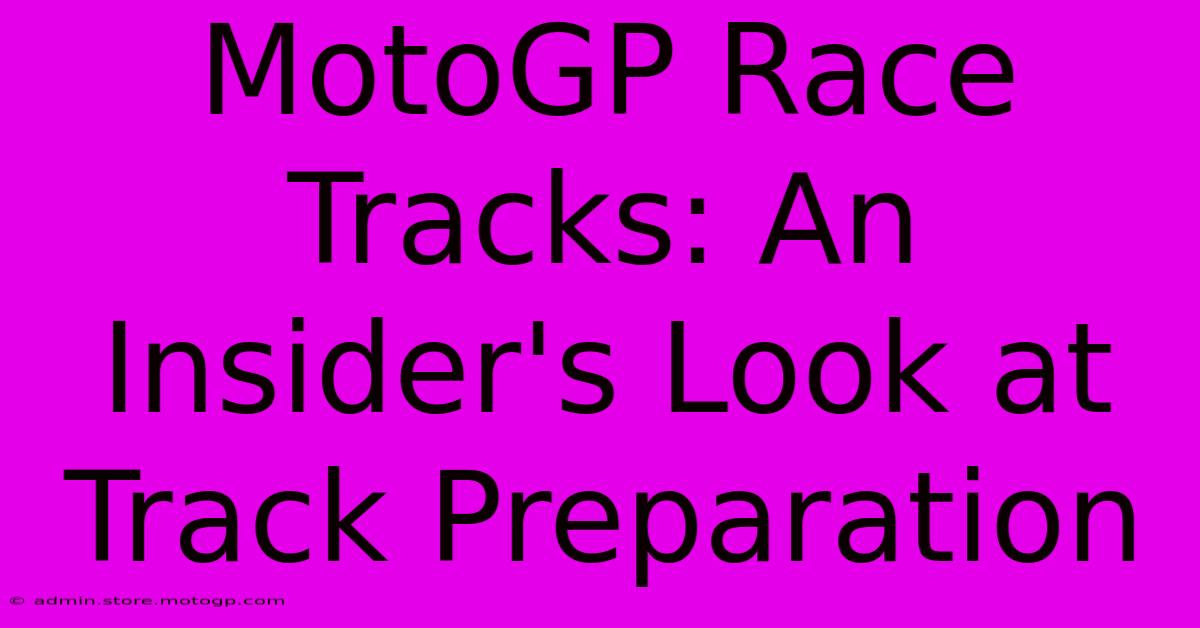MotoGP Race Tracks: An Insider's Look At Track Preparation

Table of Contents
MotoGP Race Tracks: An Insider's Look at Track Preparation
The roar of the engines, the smell of burning rubber, the sheer adrenaline – MotoGP races are spectacles of speed and skill. But behind the thrilling races lies meticulous preparation, weeks of work transforming seemingly ordinary circuits into high-speed battlegrounds fit for the world's best riders. This insider's look unveils the secrets behind getting a MotoGP track race-ready.
From Asphalt to Apex: The Stages of Track Preparation
Preparing a track for a MotoGP race is a complex, multi-stage process demanding precision and expertise. It's not simply about sweeping the debris; it's about optimizing every inch of the track for safety and performance.
1. The Pre-Inspection: Identifying and Addressing Issues
Weeks before the race weekend, track inspectors meticulously examine every aspect of the circuit. This detailed inspection identifies potential hazards, from cracks in the asphalt to inadequate drainage. Safety is paramount, and any issues, no matter how minor, are addressed promptly. This includes:
- Asphalt repairs: Addressing potholes, cracks, and any surface imperfections to ensure a smooth racing surface.
- Drainage system check: Ensuring efficient water removal to prevent aquaplaning and maintain optimal track conditions, even in wet weather.
- Run-off area assessment: Checking the condition and effectiveness of the run-off areas, designed to safely slow down errant bikes. This includes ensuring adequate gravel traps and barriers.
- Barrier inspection: Thorough inspection and repair of the safety barriers to ensure they meet stringent safety standards.
2. Surface Cleaning and Preparation: A Pristine Racing Canvas
Once potential hazards are rectified, the track undergoes a thorough cleaning. This isn't a simple sweep; it involves:
- Removing debris: Eliminating all loose materials, including dirt, gravel, rubber deposits from previous races, and even insects.
- Cleaning the surface: Utilizing specialized cleaning equipment to ensure the track surface is free from oil, grease, and other contaminants that could affect rider grip.
- Applying track sealant (where necessary): This process can improve grip and maintain the integrity of the asphalt.
3. Track Layouts and Markings: Guiding the Riders
The track layout itself plays a crucial role. This phase includes:
- Marking the track: Precisely painting lines, arrows, and other markings to clearly guide riders and officials.
- Installing signage: Placing clear and visible signage indicating crucial information, such as speed limits in specific areas.
- Setting up the timing system: Ensuring accurate timing and tracking of the riders' positions and speeds.
4. Safety Checks and Final Inspection: The Final Countdown
The final stage involves a rigorous series of checks to ensure everything is in perfect working order. This includes:
- Marshalling post checks: Confirming the marshals' preparedness and communication systems are operational.
- Medical facilities check: Ensuring the medical teams and facilities are ready to handle any potential incidents.
- Final track walk: A final walk-through by officials and experts to verify all aspects of track preparation are completed flawlessly.
The Importance of Track Preparation in MotoGP
The meticulous preparation isn't just about aesthetics; it's about rider safety and fair competition. A well-prepared track minimizes risks, ensuring a level playing field where riders can showcase their skills without unnecessary hazards. This level of preparation underscores the dedication to safety and the high standards expected in the pinnacle of motorcycle racing.
Keywords: MotoGP, Race Tracks, Track Preparation, Motorcycle Racing, Safety, Asphalt, Drainage, Run-off Area, Barriers, Cleaning, Markings, Timing System, Marshals, Medical Facilities, Rider Safety, Fair Competition
Off-Page SEO Considerations:
To further boost this article's ranking, consider these off-page SEO strategies:
- Guest posting: Contribute articles related to MotoGP or motorsports to relevant websites.
- Social media promotion: Share the article on platforms like Twitter, Facebook, and Instagram, using relevant hashtags.
- Building backlinks: Reach out to other websites in the motorsports niche and request backlinks to this article.
- Forum participation: Engage in relevant online forums and communities, subtly incorporating links to the article where appropriate.
By implementing both on-page and off-page SEO strategies, you can significantly enhance the visibility and ranking of this article in search engine results. Remember consistency is key in SEO, so keep creating valuable content and promoting it effectively.

Thank you for visiting our website wich cover about MotoGP Race Tracks: An Insider's Look At Track Preparation. We hope the information provided has been useful to you. Feel free to contact us if you have any questions or need further assistance. See you next time and dont miss to bookmark.
Featured Posts
-
F1 Shuttle Service The Preferred Way To Travel
Feb 18, 2025
-
Formula 1 Parking The Best Parking Advice For Race Fans
Feb 18, 2025
-
Experience Cota Like A Pro Open Track Days
Feb 18, 2025
-
F1 Ratings Unlocking The Secrets To Success In F1
Feb 18, 2025
-
Moto Gp Photos Get Your Fix Of Speed And Thrills
Feb 18, 2025
